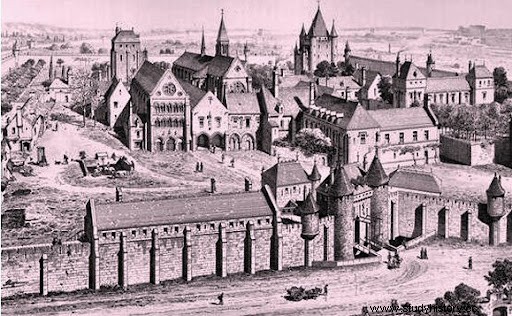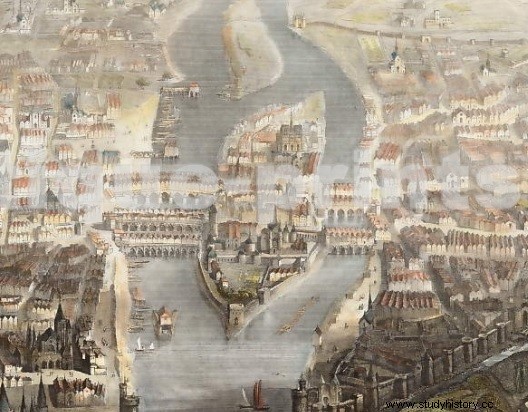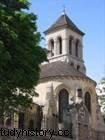 The city of Paris was founded around 250 BC on the Ile de la Cité by the Gallic tribe of the Parisii. At the time, it was a fortified town called Lutetia (Lutèce). In 52 BC, the city was conquered by the Romans, who gave it the name of Civitas Parisorium (Paris). Paris becomes the capital of the Frankish kingdom at the beginning of the 6th century. Under the Capetians, the city was adorned with fortifications and numerous buildings, concentrated within the Île de la Cité. Over the centuries, Paris gradually expanded to occupy both banks of the Seine and became the largest city in medieval Christian Europe.
The city of Paris was founded around 250 BC on the Ile de la Cité by the Gallic tribe of the Parisii. At the time, it was a fortified town called Lutetia (Lutèce). In 52 BC, the city was conquered by the Romans, who gave it the name of Civitas Parisorium (Paris). Paris becomes the capital of the Frankish kingdom at the beginning of the 6th century. Under the Capetians, the city was adorned with fortifications and numerous buildings, concentrated within the Île de la Cité. Over the centuries, Paris gradually expanded to occupy both banks of the Seine and became the largest city in medieval Christian Europe.
Paris, capital of the kingdom
In 486, Clovis I seized Paris and made it, at the beginning of the 6th century, the capital of the Frankish kingdom. The city took on new life and developed on both banks of the Seine. As Christianity flourished, Paris then experienced a period of intense religious influence, with the construction of abbeys and priories (Saint-Germain-l'Auxerrois). But the city was abandoned by the last Merovingians and then by the Carolingians, Charlemagne having chosen Aix-la-Chapelle as the capital. During the 9th century, Paris had to fight against the invasions of the Vikings, and the city was subjected to a long siege in 885-886. The Parisians repel the attackers under the leadership of Count Eudes and Bishop Gozlin.
 At the advent of the Capetian dynasty in 987, Paris became the capital of the kingdom of France and experienced a rapid political, economic and urban development. To protect the city, Philippe Auguste had a powerful stone wall built (1180-1223), reinforced by the Louvre fortress (1204) and the Nesle tower. The streets are cobbled, and the market of Les Halles was created in 1183. Bridges (Petit-Pont, Pont-au-Change) connect the Ile de la Cité to the commercial right bank and to the left bank, where the University (1215). The construction, on the Ile de la Cité, of the Notre-Dame cathedral (undertaken in 1163 by Bishop Maurice de Sully) then that of the Sainte-Chapelle (1246-1248) under Saint Louis and finally the enlargement of the Royal Palace under Philippe le Bel (1285-1314) contributed to making the City the political and religious heart of the kingdom of France.
At the advent of the Capetian dynasty in 987, Paris became the capital of the kingdom of France and experienced a rapid political, economic and urban development. To protect the city, Philippe Auguste had a powerful stone wall built (1180-1223), reinforced by the Louvre fortress (1204) and the Nesle tower. The streets are cobbled, and the market of Les Halles was created in 1183. Bridges (Petit-Pont, Pont-au-Change) connect the Ile de la Cité to the commercial right bank and to the left bank, where the University (1215). The construction, on the Ile de la Cité, of the Notre-Dame cathedral (undertaken in 1163 by Bishop Maurice de Sully) then that of the Sainte-Chapelle (1246-1248) under Saint Louis and finally the enlargement of the Royal Palace under Philippe le Bel (1285-1314) contributed to making the City the political and religious heart of the kingdom of France.
The three parts of medieval Paris (the Cité, the shopping right bank and the university left bank) are expanding and gaining in importance. Two authorities, often rivals, are established. A provost of the king, installed at the Châtelet, directs the city in place of the monarch. A provost of the merchants, residing at the Town Hall, is responsible for the markets for the corporations. In 1257, Robert de Sorbon, confessor of Saint Louis, received authorization to create a college, the Sorbonne. Students flocked from all countries and the University of Paris became one of the great intellectual centers (theology, philosophy) of medieval Christianity. His great masters include Bonaventure, Thomas Aquinas and Jean de Gerson. With nearly 100,000 inhabitants, Paris became, in the 13th century, the largest city in Christian Europe.
A well-hidden medieval Paris
Let's explore Medieval Paris , of which we know the greatest monuments but which also knows how to be more discreet; so you have to know where to look...Let's start first with the center, the very heart of Paris with the Ile de la Cité:Notre-Dame Cathedral , undertaken by Bishop Maurice de Sully around 1160, but completed almost a century later:unmissable despite the crowds; you must also have fun observing the forecourt, where you can guess the layout of the medieval streets! On the same island was erected by Saint Louis the Sainte-Chapelle between 1243 and 1248, to house the Crown of Thorns and other relics. Its interior maintenance leaves something to be desired, but it is still worth a detour.
 Let's cross the left bank, with the Collège des Bernardins, rue de Poissy, installed by the Cistercians in 1246, and the very pretty Saint-Séverin church, from the first third of the 13th century (in the heart of the Latin Quarter). Then let’s go further south to try to find remains of the surrounding wall, dating from the time of Philippe Auguste (between 1190 and 1211):it’s done at 3, rue de Clovis and at 48-50 rue Cardinal-Lemoine, in the 5th arrondissement. Other traces of this wall can be found in the capital, on the right bank this time, at 57 rue des Francs-Bourgeois (4th arrondissement), rue des Jardins de Saint-Paul (also 4th) and at 11 rue du Louvre (1
st
). However, it is sometimes necessary to have a very watchful eye...Fortunately, not far away, in the street conveniently called Etienne Marcel, stands the very well preserved Tour Jean sans Peur, dating from the beginning of the 15th century, in the midst of the Hundred Years War.
Let's cross the left bank, with the Collège des Bernardins, rue de Poissy, installed by the Cistercians in 1246, and the very pretty Saint-Séverin church, from the first third of the 13th century (in the heart of the Latin Quarter). Then let’s go further south to try to find remains of the surrounding wall, dating from the time of Philippe Auguste (between 1190 and 1211):it’s done at 3, rue de Clovis and at 48-50 rue Cardinal-Lemoine, in the 5th arrondissement. Other traces of this wall can be found in the capital, on the right bank this time, at 57 rue des Francs-Bourgeois (4th arrondissement), rue des Jardins de Saint-Paul (also 4th) and at 11 rue du Louvre (1
st
). However, it is sometimes necessary to have a very watchful eye...Fortunately, not far away, in the street conveniently called Etienne Marcel, stands the very well preserved Tour Jean sans Peur, dating from the beginning of the 15th century, in the midst of the Hundred Years War.
Left bank again, we continue south to find remains of the Cordeliers convent, rue de Julienne in the 13th. Established in the 1270s, outside the enclosure, by Canon Galen of Pisa with the support of Philip III; Unfortunately, there isn't much left...
Let's now go back to the northwest, towards a "nest" of medieval remains, around the the abbey church of Saint-Germain-des-Prés> :it is, just like Notre-Dame, a must in medieval Paris, with traces dating from the 11th century until the end of the 13th century. The neighborhood is also very nice (but expensive).
 Let's cross the Seine, for the right bank:in addition to the remains of the wall already mentioned, the big piece is obviously the Louvre:everything is in the basement, but the museum has arranged it remarkably well, and you can discover the remains of the surrounding wall and the Saint-Louis room. A must on any visit to the Louvre. Then you have to be brave to reach the 18th arrondissement, at 2 rue Mont-Cenis, to admire the pretty Saint-Pierre-de-Montmartre church , dating from the 12th century.
Let's cross the Seine, for the right bank:in addition to the remains of the wall already mentioned, the big piece is obviously the Louvre:everything is in the basement, but the museum has arranged it remarkably well, and you can discover the remains of the surrounding wall and the Saint-Louis room. A must on any visit to the Louvre. Then you have to be brave to reach the 18th arrondissement, at 2 rue Mont-Cenis, to admire the pretty Saint-Pierre-de-Montmartre church , dating from the 12th century.
Finally back to the center of Paris, still on the right bank, to discover an interesting district, in the 3rd arrondissement, with the church of the priory Saint-Martin-des-Champs, the refectory and a turret of the enclosure, all from the 13th century. These are most of the visible monuments, medieval Paris having been greatly turned upside down by the Paris of the Ancien Régime, that of the Revolution and that of Haussmann. But that's another story...
Bibliography
- The Paris of the Middle Ages, by Boris Bove. Belin, 2018.
- Paris in the Middle AgesParis in the Middle Ages, by Florian Meunier. West-France, 2014.
- Atlas of Paris in the Middle Ages:urban space, habitat, society, religion, places of power by Philippe Lorentz
To go further
- The National Museum of the Middle Ages in Cluny.
